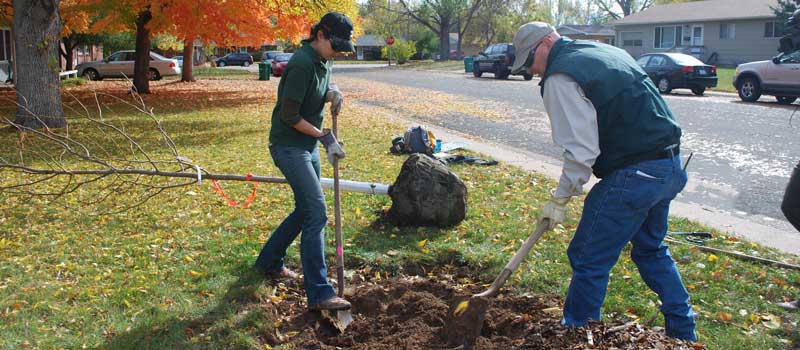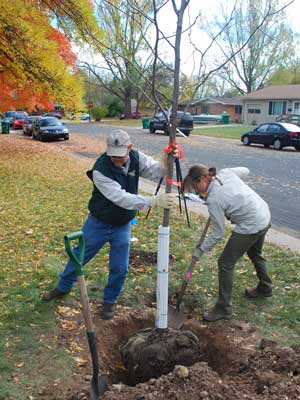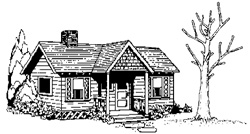Selecting, Planting & Caring for Trees

Right Tree, Right Place, Right Time
Careful planning is necessary when selecting and planting a tree. It is important to plant the right tree in the right location at the right time of year. In Colorado, it is best to plant trees in spring or fall, when temperatures are not so extreme. Also, matching a tree to its planting site is critical and a long-term decision – most trees can outlive the people who plant them!
When you plant the right trees in the right places, they provide so many benefits. Trees in our communities:
- Shade homes, businesses and streets
- Increase property values
- Reduce energy costs
- Make neighborhoods safer
- Improve people’s health
- Reduce noise pollution
- Add color, beauty and scenery
- Provide habitat for birds and other wildlife
- Clean our air and water
- Reduce storm water run-off
The tips below are for trees suited for communities and urban settings. They apply to large container or balled-and-burlap trees. For tips on planting seedling trees suited for wildland forests, please visit the CSFS Seedling Tree Nursery.
How to Plant a Tree
Tips for Selecting, Planting and Caring for Trees in Communities
These tips were excerpted from Recommended Trees: A Guide for Selecting, Planting, and Caring For Trees (233 KB PDF).

Site Considerations
- Available space above and below ground
- Water availability
- Drainage
- Soil texture and pH
- Sunlight levels/exposure
- Weather and other environmental factors
Tree Considerations
- Growth rate of the species selected
- Mature size
- Form
- Hardiness ability of a plant to survive low temperatures
- Heat tolerance and drought tolerance
- Pest resistance
- Maintenance issues
- Native versus nonnative species
Selecting Trees at the Nursery
When you buy a high-quality tree correctly, plant and properly treat it. Both you and your tree will benefit for many years. When you buy a low-quality tree, you and your tree will have many costly problems, even if you take great care in planting and maintenance.
Things to Consider
- Tree should appear healthy. No discolored bark, wilted leaves, etc.
- Branches should be evenly spaced around the trunk
- Trunk should taper from a solid base, gradually becoming more slender towards the top
- Tree foliage and branches should be distributed on upper 2/3 of tree
- Tree should contain a central, dominant leader
- Tree should be free from mechanical damage
- Tree should be free from insects and diseases
- Roots should not be girdling, circling or pot-bound
Remember to call 811 a few business days before digging to request the approximate location of buried utilities so you don’t unintentionally dig into an underground utility line.
- Dig a hole 2-3 times the diameter of the root ball of the tree being planted and no deeper than the root ball. Use a shovel to measure the depth of your planting hole. When planted, the top of the root ball should be slightly above ground level. The root collar (flare) must be visible 1 inch above final grade after planting; trees planted too deep will drown.
 For balled-and-burlap trees, remove the bottom portion of the wire basket. Slowly place the tree in the premeasured hole, being careful not to fracture the root ball. Remove the rest of the wire basket. Remove any remaining wire and twine, then peel back and remove as much of the burlap as possible. For large container trees, completely remove the container. It is important to remove the entire wire basket or container, as these materials can damage root development.
For balled-and-burlap trees, remove the bottom portion of the wire basket. Slowly place the tree in the premeasured hole, being careful not to fracture the root ball. Remove the rest of the wire basket. Remove any remaining wire and twine, then peel back and remove as much of the burlap as possible. For large container trees, completely remove the container. It is important to remove the entire wire basket or container, as these materials can damage root development.- Set the root ball on solid ground in the hole and not on loose backfill; this eliminates settling.
- After the root ball is in the hole, check to confirm that the root flare (the flare where the trunk meets the root) is visible. You may have to pull back some of the dirt from the root ball.
- Backfill the hole with the original soil. Adding peat moss, manure or fertilizer to the soil in the planting hole is not necessary and not recommended. Too much added nutrients can cause a “potted tree” effect and restrict root growth.
- Place mulch 3-4 inches deep and at least as wide as the planting hole, but do not mulch within 3-6 inches from the trunk of the tree. This will protect roots, hold soil moisture, reduce weed growth and provide a protective strip to eliminate mechanical damage from lawnmowers and weed-eaters. Porous landscape cloth may be placed between the soil and the mulch, but do not use plastic and do not bury the root flare. Keep grass and weeds out of mulched areas as they compete for the same water and nutrient resources as the new tree.
- If necessary, stake the tree to keep the root ball from shifting in strong winds. The main tree stem must be able to sway. If it is too rigid, root and stem growth will be adversely affected.
- Use wide straps to tie trees to stakes. Do not use wire, string, rope or rubber hose around a tree. These structures can girdle or “strangle” a growing tree.
- Remove stakes and straps after roots are established, usually after one or two growing seasons.
- Keep soil moist but not saturated. Irrigation is necessary, especially during the heat of summer (water in the early morning or at dusk) and in dry winters (take care not to freeze your pipes).
- Optimal periods for planting trees in Colorado are spring (March 15 to June 15) and fall (Sept. 1 to Oct. 15), when outdoor temperatures are not so extreme.
Follow these recommendations to help establish your tree:
- Water deeply and slowly. Apply water so it moistens the critical root zone (from near the trunk of the tree to the dripline) to a depth of 12 inches. Methods for watering include a deep root fork or needle, soaker hose or soft spray wand. Apply water to many locations under the dripline. If a deep root fork or needle is used, insert the device no deeper than eight inches into the soil.
- Consistent moisture is essential. Maintaining consistent soil moisture allows for better root water absorption. Drought stressed or over-watered trees are more vulnerable to disease and insect infestations, as well as branch dieback.
- Generally, a newly planted tree should be watered every three to five days during the growing season, depending on weather and soil conditions. Remember that newly planted trees also need water during dry periods in the winter months. Try to water at least once a month in the dormant season.
- Use the following “rule of thumb” for applying the proper amount of water: apply 10 gallons of water per inch of tree diameter; for instance a one-inch tree will require 10 gallons of water each time it is watered. For mature trees 10 inches in diameter or more, apply 15 gallons of water per inch of tree diameter. Use a ruler to measure your tree’s diameter.
- Mulch helps conserve and is critical to soil moisture. Apply organic mulch within the drip line, at a depth of three to four inches. It’s best to eliminate turf prior to adding mulch. Leave a six-inch space between the mulch and trunk of trees. Mulch materials may include wood chips, bark, leaves and evergreen needles.
Limit Pruning of Newly Planted Trees
- Remove torn or broken branches (save other pruning measures for the second or third year). Once the tree has established a good root system after planting (usually within 1 to 3 years), proper pruning is essential in developing a tree with a strong structure and desirable form.
Location of Pruning
- Location of a pruning cut is critical to a tree’s response in growth and wound closure.
- Pruning cuts should be made just outside the branch collar. The branch collar contains trunk or parent branch tissues, and the tree will be harmed if you remove or damage it. If the cut is large, the tree may suffer permanent internal decay.

For Most Young Trees, Maintain a Single Dominant Leader
- Do not prune back the tip of this leader.
- Do not allow secondary branches to outgrow the leader.
- Sometimes, a tree will develop double leaders known as co-dominant stems. These can lead to structural weaknesses, so it is best to remove one while the tree is young.
- A good structure of primary scaffold branches should be established while the tree is young. The scaffold branches provide the framework of the mature tree.
Do Not Top Your Trees!
Trees that have been topped may become unsightly and hazardous.
Avoid topping trees. Topping leads to:
- Starvation
- Shock
- Insects and diseases
- Weak limbs
- Rapid new growth
- Tree death
- Ugliness
- Increased maintenance costs
Contact your local tree expert for more information:
- Local Community Tree Board
- City Forester
- City Parks Department
- Arborist
- Forestry Consultant
- Tree Nursery
- Colorado State University Extension
- Your local CSFS forester
The CSFS and Colorado State University Extension offer publications that provide great tips on the selection, planting and care of trees and shrubs.

